Sonos is a premium wireless home sound system, known for its high-quality sound and user-friendly multi-room experience, enhanced by Trueplay™ tuning technology. For those who want to get the most out of their system, Qobuz is an excellent choice, offering over 100 million songs in up to 24-bit Hi-Res quality.
If you wonder how to connect Sonos and Qobuz to enjoy studio-quality sound throughout your home, you're in the right place. This guide will walk you through how to play Qobuz on Sonos, explain the requirements, and offer tips to optimize your setup. Get ready to bring your favorite Qobuz music to life with incredible clarity and depth.
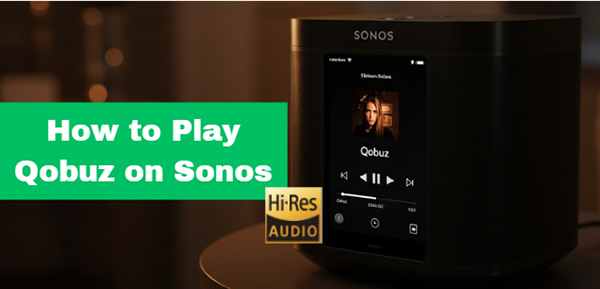
Part 1. Does Qobuz Work with Sonos?
Yes, the Qobuz and Sonos integration has been available for years. Qobuz was the first music service to offer 24-bit Hi-Res audio streaming directly on Sonos speakers. You can add Qobuz as a music service directly within the Sonos app or Sonos Controller app, allowing you to browse and play its extensive library of high-resolution and CD-quality lossless audio seamlessly. Before setting up, make sure you have:
- A Sonos speaker that supports Sonos S1 or Sonos S2 (for Hi-Res up to 24 bit/48kHz).
- The latest Sonos app is installed on your iOS or Android device.
- The latest Sonos Controller app is installed on your Windows or macOS computer.
- An active Qobuz Studio or Sublime subscription.
- A stable Wi-Fi network.
Note:
- Only the modern S2 software platform can handle HiRes audio playback (24-bit/48kHz.). If you are still on the older S1 system, you will be limited to CD quality (16-bit/44.1kHz).
- Not all Sonos speakers can play 24-bit Hi-Res Qobuz audio. You will need a newer model such as a Sonos Arc, Beam (Gen 2), Era 100, Era 300, Five, or Move 2.
Part 2. How to Play Qobuz on Sonos via Sonos App
With the prerequisites confirmed, integrating Qobuz directly into your Sonos app is simple. This method is highly recommended as it creates the most stable connection and allows you to control your Qobuz music from within the Sonos ecosystem.
Connect Qobuz to Sonos on iPhone/iPad/Android
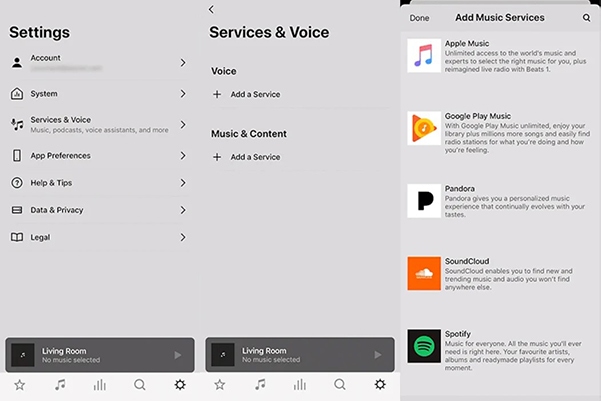
Step 1. Open the Sonos app on your mobile device. Navigate to the 'Settings' tab by tapping the gear icon in the navigation bar at the bottom of the screen.
Step 2. In the Settings menu, tap on 'Services & Voice'. Under the "Music & Content" heading, select the 'Add a Service' option.
Step 3. Scroll through the list of available music services and tap on 'Qobuz'. You will then be prompted to tap the 'Add to Sonos' button.
Step 4. The app will now ask you to authorize your account. Tap the 'Authorize' button and enter your Qobuz email address and password on the login screen that appears.
Step 5. You can now search for artists, albums, and playlists from Qobuz directly within the Sonos app and see a quality badge on the "Now Playing" screen to confirm you're streaming in Hi-Res or CD Lossless.
Add Qobuz to Sonos on Mac/Windows PC
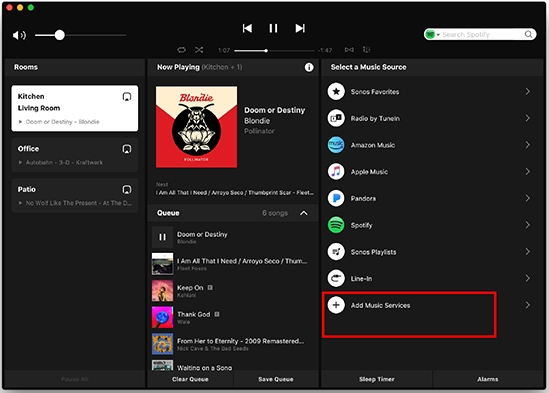
Step 1. Launch the Sonos S1 or S2 Controller app on your macOS or Windows computer.
Step 2. Click the 'Add Music Services' option under the 'Select a Music Source' section.
Step 3. Find and select 'Qobuz' from the list. Follow the on-screen instructions to authorize your Qobuz account and add Qobuz to Sonos.
Step 4. Once linked, Qobuz will appear in your Sonos app's Browse tab. Search for music, explore playlists, and enjoy high-quality audio.
Part 3. How to Play Qobuz on Sonos without a Subscription
Streaming Qobuz directly to Sonos requires an active Qobuz subscription. However, there is a way to bypass this by creating a local, offline library of your favorite Qobuz tracks.
Sonos speakers support playing local files encoded in MP3, AAC, M4A, OGG, WMA, FLAC, ALAC (Apple Lossless), WAV, and AIFF output formats. You can use DRmare Streaming Audio Recorder to download and convert the Qobuz music to a format compatible with Sonos. Once the files are on your computer, you can play them on your Sonos system as a local music library, even without a Qobuz subscription.
DRmare Streaming Audio Recorder is a tool that allows you to download music from various streaming services, including Qobuz. It can convert Qobuz tracks into formats like MP3, FLAC, WAV, and more. This method not only lets you listen to Qobuz on Sonos without a subscription but also gives you a permanent, offline copy of your Qobuz music. It is also designed to download Qobuz music at a fast speed while preserving the high-quality sound and all original ID3 tags.
How to Download and Play Qobuz Music on Sonos for Free
- Step 1Configure Qobuz Music Output Parameters for Sonos
Launch the DRmare Streaming Audio Recorder on your Mac or Windows computer. By default, the software downloads Qobuz music in a lossless format, which is perfect for Sonos. However, if you want to customize your settings, click the 'Menu' icon, select 'Preferences', and then navigate to the 'Conversion' tab. Here, you can select your preferred output format (like FLAC for high-res quality or MP3 for smaller file sizes) and adjust other parameters. Click 'OK' to save your changes.
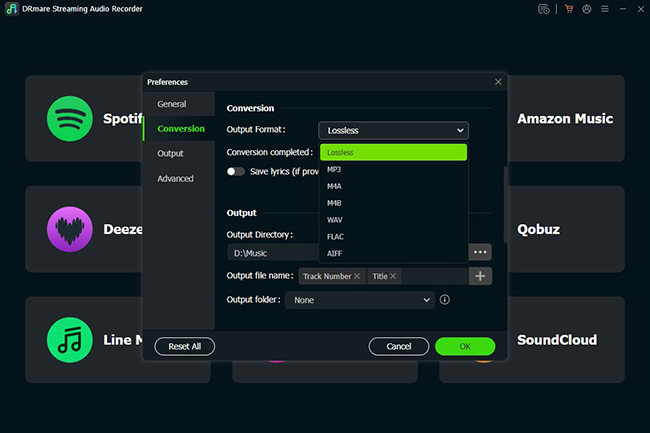
- Step 2 Add Qobuz Music to Download
On the main screen of the DRmare application, click the 'Qobuz' icon to open the built-in Qobuz web player. Log in to your Qobuz account and browse your library to find the albums or playlists you want to play on Sonos. To add them to the conversion list, click the 'Add' >'Add to list' button.
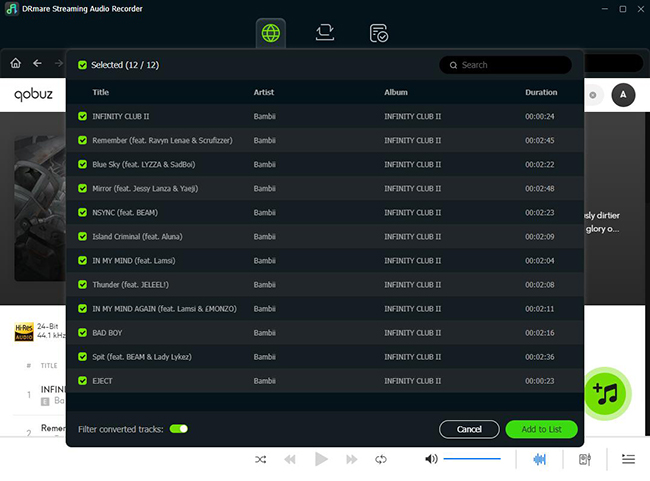
- Step 3 Download Qobuz Music for Sonos Speaker
After you've selected all the Qobuz tracks you want, click the 'Convert' button to start the downloading process. DRmare Streaming Audio Recorder will quickly convert and save the Qobuz tracks as local files compatible with Sonos on your computer.
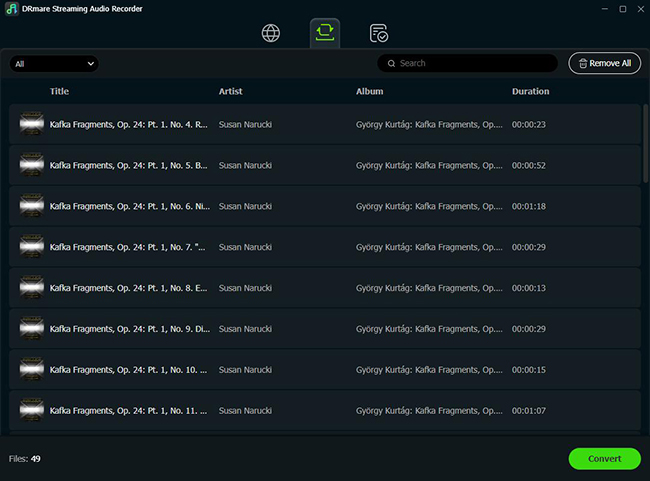
- Step 4 Set up Your Local Music Library on Sonos
Once your Qobuz songs are downloaded as local files, you need to add them to your Sonos music library. After that, you can listen to them on your Sonos even if you cancel your Qobuz plan.
- Share your Qobuz music folder stored on your computer on your local network.
- On Windows: In File Explorer, right-click your music folder, go to 'Properties' > 'Sharing' > 'Advanced Sharing', and enable sharing with the proper read permissions.
- On macOS: Go to 'System Settings' > 'General' > 'Sharing' and enable 'File Sharing'. Add your music folder to the list of shared folders.
- Open the Sonos Control app on your computer. Go to the Settings menu, and navigate to 'System' > 'Music Library' > 'Add Shared Music Folder'.
- Follow the on-screen instructions to enter the network path to your folder where you saved your converted Qobuz files.
- Sonos will then index your local music library. After this is complete, you can find your Qobuz tracks under the "Music Library" section in your Sonos app and play them offline on any of your speakers.
Part 4. FAQs about Connecting Qobuz and Sonos
What Qobuz Audio Quality Does Sonos Support?
Sonos supports two levels of high-quality audio from Qobuz, depending on your system: 24-bit / 48 kHz on a Sonos S2 system, and 16-bit / 44.1 kHz on a Sonos S1 system.
Are There Other Ways to Play Qobuz on Sonos?
Yes, besides the direct integration within the Sonos app, there are two other common methods:
- AirPlay 2: If you have an iPhone, iPad, or Mac, you can stream directly from the native Qobuz app to any AirPlay 2-compatible Sonos speaker. This method also supports Hi-Res audio up to 24-bit / 48 kHz and is a great option if you prefer the Qobuz interface.
- Bluetooth: For Sonos speakers that are Bluetooth-enabled (like the Roam, Move, and Era series), you can pair your device and stream from the Qobuz app. This is convenient but will not deliver lossless or Hi-Res quality, as Bluetooth audio is compressed.
In Which Regions Is Qobuz Added to Sonos?
The Qobuz service is available on Sonos in all countries where Qobuz has officially launched. This includes:
Andorra, Anguilla, Argentina, Australia, Austria, Belgium, Bermuda, Brazil, Canada, Chile, Colombia, Cook Islands, Denmark, Faroe Islands, Finland, France, French Guiana, French Polynesia, Germany, Gibraltar, Greenland, Grenada, Guadeloupe, Ireland, Italy, Japan, Luxembourg, Martinique, Mauritius, Mexico, Monaco, Montserrat, Netherlands, New Caledonia, New Zealand, Norway, Portugal, Saint Kitts and Nevis, Saint Vincent and the Grenadines, Seychelles, Spain, Sweden, Switzerland, Turks and Caicos Islands, United Kingdom, United States of America, Virgin Islands, British, Wallis and Futuna.
Does Sonos Support Qobuz Connect?
No, Sonos does not support a "Qobuz Connect" feature in the same way it supports Spotify Connect. No feature allows you to use the native Qobuz app to directly hand off the stream to your Sonos speakers and use the Qobuz app as a remote.
Are Voice Commands Available with Quboz and Sonos?
Yes. If you have Alexa or another supported voice assistant set up on your Sonos speaker, you can use basic voice commands like play, pause, skip, and volume control when Qobuz is playing through Sonos.
How to Troubleshoot Sonos Qobuz Problems?
Here are solutions to the most common issues:
- Authorization Fails: This is almost always due to a typo in the password. Carefully re-enter your credentials. If it persists, try resetting your password on the official Qobuz website and then try again.
- The "Hi-Res" Badge is Missing: First, confirm the track you are playing is actually offered in Hi-Res on Qobuz. If it is, ensure your Sonos speaker is a compatible Hi-Res model and that your entire system is updated to the S2 software.
- Tracks are Greyed Out or Won't Play: This usually signifies a regional licensing issue. Unfortunately, some music is not available for streaming in certain countries, and these tracks will be unplayable.
Part 5. In Conclusion
Connecting Qobuz to your Sonos system unlocks Hi-Res streaming up to 24-bit/48 kHz on S2-compatible speakers. Whether you use the Sonos app, AirPlay 2, Bluetooth, or even local playback of downloaded tracks with the help of DRmare Streaming Audio Recorder, you'll play clear, high-quality Qobuz music on Sonos throughout your home.













User Comments
Leave a Comment